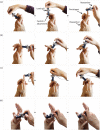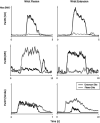Defining the design requirements for an assistive powered hand exoskeleton: A pilot explorative interview study and case series
- PMID: 33118453
- PMCID: PMC8404210
- DOI: 10.1177/0309364620963943
Defining the design requirements for an assistive powered hand exoskeleton: A pilot explorative interview study and case series
Abstract
Background: Powered hand exoskeletons are an emerging technology that have shown promise in assisting individuals with impaired hand function. A number of hand exoskeleton designs have been described in the literature; however, the majority have not been supported by patient-oriented criteria.
Objective: The aim of this study was to define preliminary end-user needs and expectations for an assistive hand exoskeleton.
Study design: Explorative interview and case series.
Methods: Six clinicians and eight individuals with impaired hand function were interviewed in small groups or individually. A standardized list of questions was used to elicit feedback on specific design criteria or promote the discovery of new criteria. In addition, three participants with impaired hand function returned for a second session where hand characteristics, such as range of motion and force required to flex/extend fingers, were recorded to further quantify design requirements.
Results: Interview responses indicated that there was general consensus among participants on criteria relating to important grasp patterns, grip strength, wear time, and acceptable bulk/weight. However, interview responses and hand characteristics also revealed important differences between individuals with impaired hand function.
Conclusion: Qualitative and quantitative data were collected to develop an understanding of end-user design requirements for assistive hand exoskeletons. Although the data collected were helpful in identifying some preliminary criteria, differences between participants exist and identifying a universal set of criteria applicable across individuals with impaired hand function is challenging. This work reinforces the importance of involving users of rehabilitation technology in the device development process.
Copyright © 2020 International Society for Prosthetics and Orthotics.
Figures




References
-
- Lawrence ES, Coshall C, Dundas R, et al.. Estimates of the prevalence of acute stroke impairments and disability in a multiethnic population. Stroke 2001; 32: 1279–1284. - PubMed
-
- Kang Y, Ding H, Zhou H, et al.. Epidemiology of worldwide spinal cord injury: a literature review. J Neurorestoratol 2018; 6: 1–9.
-
- Peters HT Page SJ and Persch A.. Giving them a hand: wearing a myoelectric elbow-wrist-hand orthosis reduces upper extremity impairment in chronic stroke. Arch Phys Med Rehabil 2017; 98: 1821–1827. - PubMed

